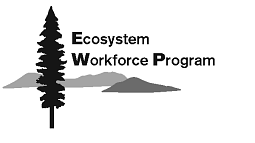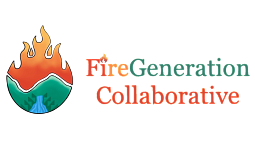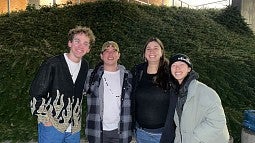Overview
What does (re)creating good livelihood systems for fire resilient communities and landscapes look like?
Fostering fire-resilient landscapes and communities requires ongoing work. This includes civic efforts like advocacy, education, and governance, as well as field work like stewarding lands and food systems (including prescribed and cultural burning), managing wildfires, and retrofitting the built environment. There are increasing calls for large-scale investments in workforce development to meet these needs.
Workforce discussions often leave out historical contexts, projected changes, and the perspectives of current and future workers and practitioners who are working on or toward fire resilience. Workforce development initiatives can perpetuate colonial and extractive labor practices that continue to harm workers, communities, and ecosystems. Collaborative research led by the Ecosystem Workforce Program and FireGeneration Collaborative, characterizes and reimagines the workforces supporting fire resilience in the western U.S.

Our Approach
We draw from four methods:
- Literature review of historical themes, existing knowledge, and active recommendations about fire resilience workforces and livelihoods.
- Interviews and survey input with with experienced fire personnel and subject matter experts.
- Collaborative listening circles with young people (ages 16-30) who are working in fire careers or interested in future involvement.
- Surveys to understand young peoples' interest in involvement in fire-related efforts.
Our research seeks to offer insights and recommendations in ways that uphold Indigenous sovereignty, empower worker wellbeing, support historically-excluded involvement, cultivate sustainable environments, and encourage local, decentralized action.

Our Results
Our research team is developing reports and insights for the fire community, decision-makers, philanthropists, and the broader public as an effort to improve careers, livelihoods, policies, and resource allocation in ways that enhance and expand fire resilience. A pillar of our process is accountability to our community partners. Collaborating is an ongoing and necessary effort to advance the knowledge created, and to uplift the visions and needs of people most impacted by decisions made. Reference our project map and data table for our end of project products.
Fire Resilience Futures: Workforces, Careers, and Livelihoods in the Western U.S. Project Map

Key Project Areas | Approaches | Learning and Sharing Products |
|---|---|---|
Existing Work: | Analyzing histories, futures, and policy/management/funding/community organizing recommendations and models with transferable learning. |
|
Present and Future: | Learning from topic experts and experienced fire personnel about what they do and needs for resources, research, advocacy, and collaboration. |
|
Present and Future: | Learning from the voices of the younger generation and early career individuals about involvement needs and visions. |
|
Continued Learning and Sharing: | Build collective vision and action through learning and sharing products. | Project-wide Synthesis and Takeaways Report |
Learning and Sharing Product Descriptions
- Fire Paths Report - A synthesis of historical analysis, future projections, and policy recommendations across livelihood systems in wildfire response, landscape resilience, and fire adapted communities.
- Youth Visions and Needs Report - A mixed methods project, incorporating qualitative (listening circles) and quantitative (survey) to understand youth visions and needs for living with fire. Listening circles were facilitated with groups of young people (ages 16-30) in northern California and Oregon to understand early career experiences, perceptions, and desires for working in fire resilience. The Fire Futures Survey was distributed across the western U.S. to understand young peoples' interest in fire-related jobs and involvement.
- Enacting Change for Fire Futures Report - A series of interviews with practitioners, organizational leaders, theorizers, and other subject matter experts to explore how to advance key workforce issues. Also includes results from the Fire Workforce Needs Assessment survey that was distributed summer 2025.
- Portrait Series and Zine - A collection of photographs of people who are interested in or working in the wildland fire field, as well as quotes about their experiences, visions, and needs for the future.
- Project-wide Synthesis and Takeaways Report - A summary of cross-cutting themes and key-takeaways across the various parts of Fire Resilience Futures, as well as policy, investment, and organizing recommendations.
Who We Are
The Ecosystem Workforce Program (EWP) at the University of Oregon is an applied social science research group focused on the intersection of economies, ecosystems, and communities.
The FireGeneration Collaborative (FireGen) aims to reimagine and transform fire culture, community governance access, and equitable solutions by centering Indigenous leadership and diverse young generations.
This research is funded through the Wildfire Strategies Program of Resource Legacy Fund.



Updates and Questions
We'll be sharing periodic project updates by email. You can sign up to receive updates.
Contact Us
- Annabelle Law (EWP Research Assistant)
- Kyle Trefny (EWP Research Assistant)
- Heidi Huber-Stearns (EWP Director)
- Meredith Jacobson (Graduate Research Fellow)
- Ryan Reed (FireGen Partnership Lead)
